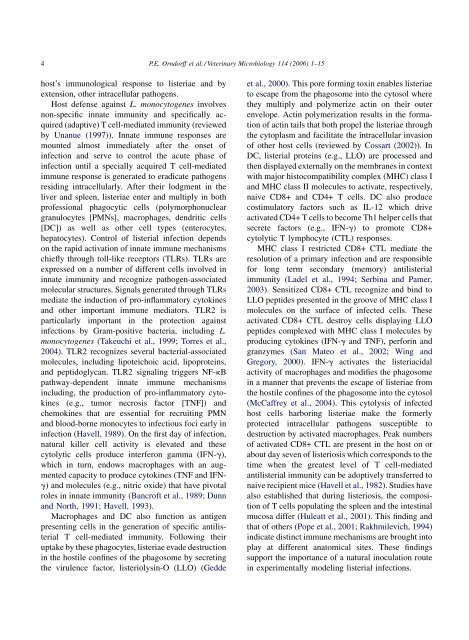Host and bacterial factors in listeriosis pathogenesis - University of ...
Host and bacterial factors in listeriosis pathogenesis - University of ...
Host and bacterial factors in listeriosis pathogenesis - University of ...
Create successful ePaper yourself
Turn your PDF publications into a flip-book with our unique Google optimized e-Paper software.
4<br />
P.E. Orndorff et al. / Veter<strong>in</strong>ary Microbiology 114 (2006) 1–15<br />
host’s immunological response to listeriae <strong>and</strong> by<br />
extension, other <strong>in</strong>tracellular pathogens.<br />
<strong>Host</strong> defense aga<strong>in</strong>st L. monocytogenes <strong>in</strong>volves<br />
non-specific <strong>in</strong>nate immunity <strong>and</strong> specifically acquired<br />
(adaptive) T cell-mediated immunity (reviewed<br />
by Unanue (1997)). Innate immune responses are<br />
mounted almost immediately after the onset <strong>of</strong><br />
<strong>in</strong>fection <strong>and</strong> serve to control the acute phase <strong>of</strong><br />
<strong>in</strong>fection until a specially acquired T cell-mediated<br />
immune response is generated to eradicate pathogens<br />
resid<strong>in</strong>g <strong>in</strong>tracellularly. After their lodgment <strong>in</strong> the<br />
liver <strong>and</strong> spleen, listeriae enter <strong>and</strong> multiply <strong>in</strong> both<br />
pr<strong>of</strong>essional phagocytic cells (polymorphonuclear<br />
granulocytes [PMNs], macrophages, dendritic cells<br />
[DC]) as well as other cell types (enterocytes,<br />
hepatocytes). Control <strong>of</strong> listerial <strong>in</strong>fection depends<br />
on the rapid activation <strong>of</strong> <strong>in</strong>nate immune mechanisms<br />
chiefly through toll-like receptors (TLRs). TLRs are<br />
expressed on a number <strong>of</strong> different cells <strong>in</strong>volved <strong>in</strong><br />
<strong>in</strong>nate immunity <strong>and</strong> recognize pathogen-associated<br />
molecular structures. Signals generated through TLRs<br />
mediate the <strong>in</strong>duction <strong>of</strong> pro-<strong>in</strong>flammatory cytok<strong>in</strong>es<br />
<strong>and</strong> other important immune mediators. TLR2 is<br />
particularly important <strong>in</strong> the protection aga<strong>in</strong>st<br />
<strong>in</strong>fections by Gram-positive bacteria, <strong>in</strong>clud<strong>in</strong>g L.<br />
monocytogenes (Takeuchi et al., 1999; Torres et al.,<br />
2004). TLR2 recognizes several <strong>bacterial</strong>-associated<br />
molecules, <strong>in</strong>clud<strong>in</strong>g lipoteichoic acid, lipoprote<strong>in</strong>s,<br />
<strong>and</strong> peptidoglycan. TLR2 signal<strong>in</strong>g triggers NF-kB<br />
pathway-dependent <strong>in</strong>nate immune mechanisms<br />
<strong>in</strong>clud<strong>in</strong>g, the production <strong>of</strong> pro-<strong>in</strong>flammatory cytok<strong>in</strong>es<br />
(e.g., tumor necrosis factor [TNF]) <strong>and</strong><br />
chemok<strong>in</strong>es that are essential for recruit<strong>in</strong>g PMN<br />
<strong>and</strong> blood-borne monocytes to <strong>in</strong>fectious foci early <strong>in</strong><br />
<strong>in</strong>fection (Havell, 1989). On the first day <strong>of</strong> <strong>in</strong>fection,<br />
natural killer cell activity is elevated <strong>and</strong> these<br />
cytolytic cells produce <strong>in</strong>terferon gamma (IFN-g),<br />
which <strong>in</strong> turn, endows macrophages with an augmented<br />
capacity to produce cytok<strong>in</strong>es (TNF <strong>and</strong> IFNg)<br />
<strong>and</strong> molecules (e.g., nitric oxide) that have pivotal<br />
roles <strong>in</strong> <strong>in</strong>nate immunity (Bancr<strong>of</strong>t et al., 1989; Dunn<br />
<strong>and</strong> North, 1991; Havell, 1993).<br />
Macrophages <strong>and</strong> DC also function as antigen<br />
present<strong>in</strong>g cells <strong>in</strong> the generation <strong>of</strong> specific antilisterial<br />
T cell-mediated immunity. Follow<strong>in</strong>g their<br />
uptake by these phagocytes, listeriae evade destruction<br />
<strong>in</strong> the hostile conf<strong>in</strong>es <strong>of</strong> the phagosome by secret<strong>in</strong>g<br />
the virulence factor, listeriolys<strong>in</strong>-O (LLO) (Gedde<br />
et al., 2000). This pore form<strong>in</strong>g tox<strong>in</strong> enables listeriae<br />
to escape from the phagosome <strong>in</strong>to the cytosol where<br />
they multiply <strong>and</strong> polymerize act<strong>in</strong> on their outer<br />
envelope. Act<strong>in</strong> polymerization results <strong>in</strong> the formation<br />
<strong>of</strong> act<strong>in</strong> tails that both propel the listeriae through<br />
the cytoplasm <strong>and</strong> facilitate the <strong>in</strong>tracellular <strong>in</strong>vasion<br />
<strong>of</strong> other host cells (reviewed by Cossart (2002)). In<br />
DC, listerial prote<strong>in</strong>s (e.g., LLO) are processed <strong>and</strong><br />
then displayed externally on the membranes <strong>in</strong> context<br />
with major histocompatibility complex (MHC) class I<br />
<strong>and</strong> MHC class II molecules to activate, respectively,<br />
naive CD8+ <strong>and</strong> CD4+ T cells. DC also produce<br />
costimulatory <strong>factors</strong> such as IL-12 which drive<br />
activated CD4+ T cells to become Th1 helper cells that<br />
secrete <strong>factors</strong> (e.g., IFN-g) to promote CD8+<br />
cytolytic T lymphocyte (CTL) responses.<br />
MHC class I restricted CD8+ CTL mediate the<br />
resolution <strong>of</strong> a primary <strong>in</strong>fection <strong>and</strong> are responsible<br />
for long term secondary (memory) antilisterial<br />
immunity (Ladel et al., 1994; Serb<strong>in</strong>a <strong>and</strong> Pamer,<br />
2003). Sensitized CD8+ CTL recognize <strong>and</strong> b<strong>in</strong>d to<br />
LLO peptides presented <strong>in</strong> the groove <strong>of</strong> MHC class I<br />
molecules on the surface <strong>of</strong> <strong>in</strong>fected cells. These<br />
activated CD8+ CTL destroy cells display<strong>in</strong>g LLO<br />
peptides complexed with MHC class I molecules by<br />
produc<strong>in</strong>g cytok<strong>in</strong>es (IFN-g <strong>and</strong> TNF), perfor<strong>in</strong> <strong>and</strong><br />
granzymes (San Mateo et al., 2002; W<strong>in</strong>g <strong>and</strong><br />
Gregory, 2000). IFN-g activates the listeriacidal<br />
activity <strong>of</strong> macrophages <strong>and</strong> modifies the phagosome<br />
<strong>in</strong> a manner that prevents the escape <strong>of</strong> listeriae from<br />
the hostile conf<strong>in</strong>es <strong>of</strong> the phagosome <strong>in</strong>to the cytosol<br />
(McCaffrey et al., 2004). This cytolysis <strong>of</strong> <strong>in</strong>fected<br />
host cells harbor<strong>in</strong>g listeriae make the formerly<br />
protected <strong>in</strong>tracellular pathogens susceptible to<br />
destruction by activated macrophages. Peak numbers<br />
<strong>of</strong> activated CD8+ CTL are present <strong>in</strong> the host on or<br />
about day seven <strong>of</strong> <strong>listeriosis</strong> which corresponds to the<br />
time when the greatest level <strong>of</strong> T cell-mediated<br />
antilisterial immunity can be adoptively transferred to<br />
naive recipient mice (Havell et al., 1982). Studies have<br />
also established that dur<strong>in</strong>g <strong>listeriosis</strong>, the composition<br />
<strong>of</strong> T cells populat<strong>in</strong>g the spleen <strong>and</strong> the <strong>in</strong>test<strong>in</strong>al<br />
mucosa differ (Huleatt et al., 2001). This f<strong>in</strong>d<strong>in</strong>g <strong>and</strong><br />
that <strong>of</strong> others (Pope et al., 2001; Rakhmilevich, 1994)<br />
<strong>in</strong>dicate dist<strong>in</strong>ct immune mechanisms are brought <strong>in</strong>to<br />
play at different anatomical sites. These f<strong>in</strong>d<strong>in</strong>gs<br />
support the importance <strong>of</strong> a natural <strong>in</strong>oculation route<br />
<strong>in</strong> experimentally model<strong>in</strong>g listerial <strong>in</strong>fections.

















